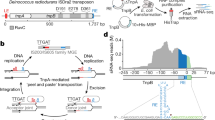Abstract
Transposition in both eukaryotes and prokaryotes is characterized by the generation of short, direct duplications of the target DNA sequence at the integration site of the transposable element1. For example, the bacterial insertion sequence IS1, or the IS1-flanked transposon Tn9, generates 9-base pair (bp) repeats during either transposition or cointegration2–8. All the transposable elements so far sequenced are characterized by the presence at their ends, of a perfect, or near-perfect, inverted repeat sequence, which is ∼30 bp long1 and is thought to be important for recognition by enzymes during transposition. While studying IS1 -mediated cointegration9–12, we found an IS1 carrying a single base pair change in the terminal inverted repeat sequence. We now report that it generates 8-bp duplications of the target sequence, a finding which confirms the importance of the inverted repeat for transposition and which, because one end only of the IS1 is changed, has implications for the mechanism of transposition by IS1.
This is a preview of subscription content, access via your institution
Access options
Subscribe to this journal
Receive 51 print issues and online access
$199.00 per year
only $3.90 per issue
Buy this article
- Purchase on Springer Link
- Instant access to full article PDF
Prices may be subject to local taxes which are calculated during checkout
Similar content being viewed by others
References
Calos, M. P. & Miller, J. H. Cell 20, 579–595 (1980).
Calos, M. P., Johnsrud, L. & Miller, J. H. Cell 13, 411–418 (1978).
Grindley, N. D. F. Cell 13, 419–426 (1978).
Johnsrud, L., Calos, M. P. & Miller, J. H. Cell 15, 1209–1219 (1978).
Devos, R., Contreras, R., van Emmelo, J. & Fiers, W. J. molec. Biol. 128, 621–632 (1979).
Kühn, S., Fritz, H. J. & Starlinger, P. Molec. gen. Genet. 167, 235–241 (1979).
Ohtsubo, E., Zenilman, M. & Ohtsubo, H. Proc. natn. Acad. Sci. U.S.A. 77, 750–754 (1980).
Galas, D. J., Calos, M. P. & Miller, J. H. J. molec. Biol. 144, 19–41 (1980).
Iida, S. & Arber, W. Molec. gen. Genet. 177, 261–270 (1980).
Iida, S. Plasmid 3, 278–290 (1980).
Iida, S., Meyer, J. & Arber, W. Cold Spring Harb. Symp. quant. Biol. 45, 27–43 (1981).
Iida, S., Meyer, J. & Arber, W. Molec. gen. Genet. (in the press).
Iida, S., Meyer, J. & Arber, W. Plasmid 1, 357–367 (1978).
Prentki, P., Karch, F., Iida, S. & Meyer, J. Gene 14, 289–299 (1981).
Ohtsubo, H. & Ohtsubo, E. Proc. natn. Acad. Sci. U.S.A. 75, 615–619 (1978).
Johnsrud, L. Molec. gen. Genet. 169, 213–218 (1979).
Fedoroff, N. V. Cell 16, 551–563 (1979).
Meyer, J., Iida, S. & Arber, W. Molec. gen. Genet. 178, 471–473 (1980).
Miller, J. H. et al. J. molec. Biol. 144, 1–18 (1980).
Shapiro, J. A. & MacHattie, L. A. Cold Spring Harb. Symp. quant. Biol. 43, 1135–1142 (1979).
Gottesman, M. M. & Rosner, J. L. Proc. natn. Acad. Sci. U.S.A. 72, 5041–5045 (1975).
De Bruijn, F. J. & Bukhari, A. I. Gene 3, 315–331 (1978).
Iida, S. & Arber, W. Molec. gen. Genet. 173, 249–261 (1979).
Grindley, N. D. F. & Sherratt, D. J. Cold Spring Harb. Symp. quant. Biol. 43, 1257–1261 (1979).
Harshey, R. M. & Bukhari, A. I. Proc. natn. Acad. Sci. U.S.A. 78, 1090–1094 (1981).
Galas, D. J. & Chandler, M. Proc. natn. Acad. Sci. U.S.A. 78, 4858–4862 (1981).
Shapiro, J. A. Proc. natn. Acad. Sci. U.S.A. 76, 1933–1937 (1979).
Arthur, A. & Sherratt, D. Molec. gen. Genet. 175, 267–274 (1979).
Gill, R., Heffron, F., Dougan, G. & Falkow, S. J. Bact. 136, 742–756 (1978).
Heffron, F., McCarthy, B. J., Ohtsubo, H. & Ohtsubo, E. Cell 18, 1153–1163 (1979).
Bolivar, F. Gene 4, 121–136 (1978).
Maxam, A. M. & Gilbert, W. Proc. natn. Acad. Sci. U.S.A. 74, 560–564 (1977).
Author information
Authors and Affiliations
Rights and permissions
About this article
Cite this article
Iida, S., Marcoli, R. & Bickle, T. Variant insertion element IS1 generates 8-base pair duplications of the target sequence. Nature 294, 374–376 (1981). https://doi.org/10.1038/294374a0
Received:
Accepted:
Issue Date:
DOI: https://doi.org/10.1038/294374a0
This article is cited by
-
Insertions of transposable elements in the promoter proximal region of the gene cluster for Escherichia coli H+-ATPase: 8 base pair repeat generated by insertion of IS1
Molecular and General Genetics MGG (1984)
Comments
By submitting a comment you agree to abide by our Terms and Community Guidelines. If you find something abusive or that does not comply with our terms or guidelines please flag it as inappropriate.



